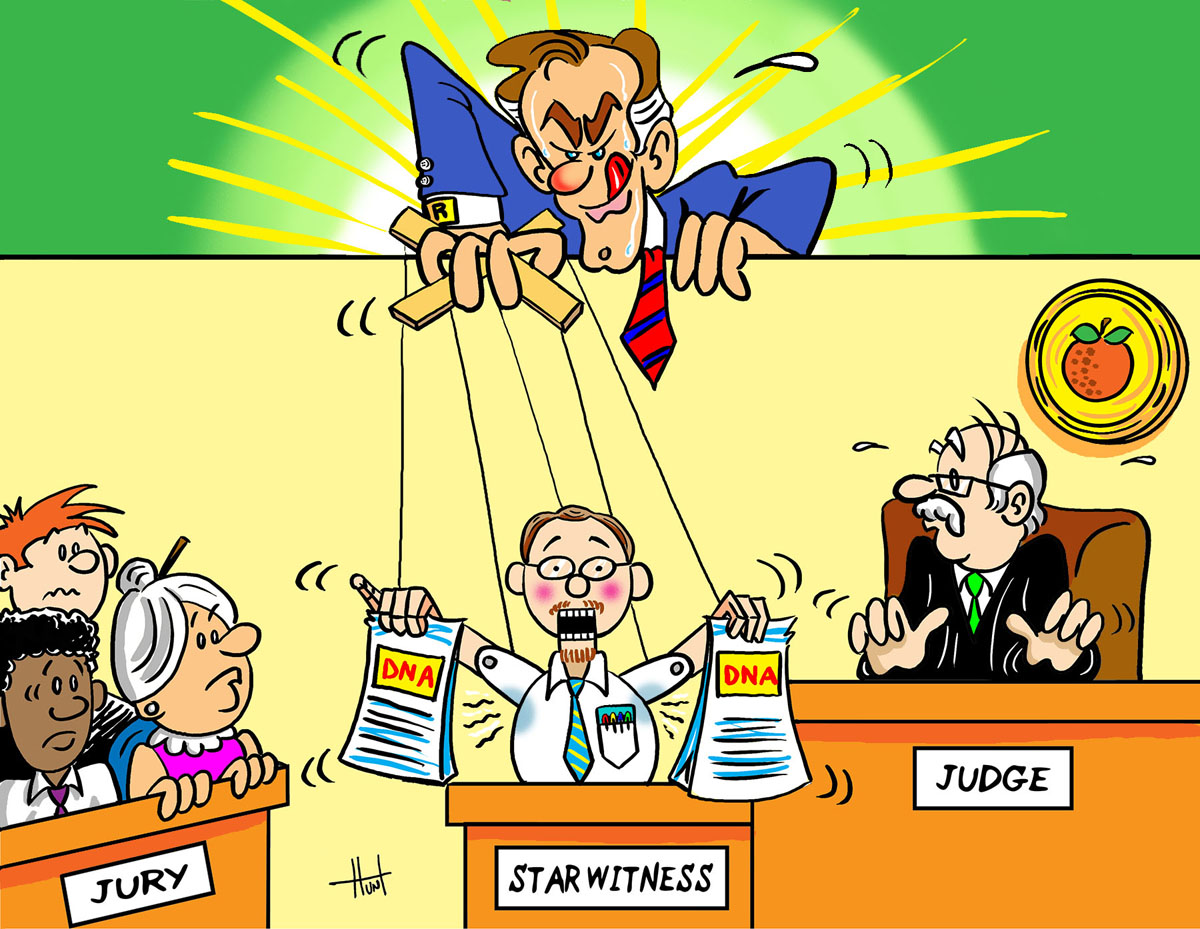
Having come under fire for his Orange County Crime Lab rendering conflicting, pro-prosecution forensic-science testimony that separate murder trial juries unwittingly accepted, director Bruce Houlihan launched a two-prong strategy: deny any wrongdoing to a news reporter, then dodge questions from the attorney who discovered the scandal.
But Houlihan’s unforced errors aren’t sitting well with Superior Court Judge Julian Bailey, who stated during a March 23 post-conviction hearing in People v. Lynn Dean Johnson that Assistant Public Defender Scott Sanders uncovered “facially inconsistent testimony.” Concerned about potential injustice, Bailey scheduled Houlihan’s appearance under oath on the witness stand in mid-April, a move he expects the County Counsel’s office to fight.
“It seems to me Mr. Sanders is entitled to something from the crime lab,” Bailey said. “He has been stymied in his efforts.”
The judge noted that Tony Rackauckas’ Orange County district attorney’s office (OCDA) has been “throwing nonsensical objections” for months in hopes of blocking a legitimate review of what crime-lab officials did to help win a controversial 2008 conviction against Johnson for the May 1985 murder and rape of 19-year-old Bridgett Lamon in Anaheim.
Last November, Judge Cheri Pham, one of Rackauckas’ former prosecutors, denied Sanders’ request for a new trial once critical information surfaced several years after the conviction. Pham didn’t directly attack his arguments, but rather she blamed timeliness. “The claims of error as presented do not amount to a potential fundamental miscarriage of justice sufficient to overcome the procedural bar against untimely requests for habeas corpus relief,” she ruled.
Unsatisfied, Sanders asked California Court of Appeal justices to weigh in, and unlike Pham, that panel has asked for a prosecutorial response before they rule.
Meanwhile, back in Bailey’s courtroom, Deputy District Attorney Avery T. Harrison followed up on his office’s unsuccessful 2017 attempt to block Sanders, one of the county’s leading exposers of prosecutorial shenanigans, from representing Johnson. Harrison is now focused on thwarting the defense attorney’s access to crime-lab records because his subpoena is “outside the scope” of what he’s legally entitled to inspect, so complying with the request would supposedly be an “unduly burdensome” task.
Besides, in Harrison’s view, Houlihan—who reports to scandal-scarred Sheriff Sandra Hutchens—performed an “extensive study” of Sanders’ claims and found them meritless, a conclusion he says should return the case to inactive status without further probing. What that study entailed is a mystery the deputy DA didn’t publicly address; he may have just taken the lab director’s word at face value. Sanders, however, responded to the dismissive assertion by asking why Houlihan, who has refused to answer any of his questions, wouldn’t want to share how he’d reached his conclusion.
Forensic scientists like to present themselves to juries as unwaveringly independent, and hopefully most stay true to that principle by refusing to bend their analyses to fit the wishes of their law-enforcement employers. But respected studies in recent years reveal dozens of crime labs nationwide perform sloppy tests and employ incompetent or deceitful characters. Locally, Johnson and People v. Wendell Lemond—a second 1985 Anaheim rape and murder, this one of Catherine Tameny—document a troubling fact: Juries have been fed tainted science. What isn’t yet known is the extent of the problem, a status quo Rackauckas is content to keep murky.

As the Weekly reported in a December 2017 cover story, “Orange County’s Informant Scandal Yields Evidence of Forensic Science Deceptions in Murder Trials,” both of the Anaheim crimes evolved into unsolved cold cases that decades later relied almost entirely on forensic-science testimony to identify the alleged culprits. Both cases also began with the OC Crime Lab’s Daniel Gammie expressing the same scientific conclusion. Gammie wrote, “The semen concentration and sperm density were very low and therefore indicated that the semen was not deposited at or near the time of death.”
Rackauckas’ office eventually faced a dilemma. Prosecutors could use the lab’s official finding to help to nail their target in one of the murders but not the other. Mary Hong, a forensic scientist working for the sheriff’s department, came to the rescue.
At Johnson’s 2008 trial, Hong labeled Gammie’s 1985 finding erroneous. She testified the window of semen deposit was actually “zero to 24 hours” before its collection at the crime scene. Given that she additionally claimed Johnson couldn’t be ruled out as the contributor, her timeline testimony aided then-prosecutor Kevin Haskins in winning a conviction.
Haskins, who is now a judge, inadvertently helps us appreciate Hong’s duplicity, according to court records. During the trial, he asked her what she objected to in Gammie’s report. Hong replied that low semen concentrations and sperm densities could not be used to conclude the deposit happened far before the death because there are too many variables, including the age and health of the donor as well as the frequency of ejaculations.
But just 15 months later, in the same courtroom with the same presiding judge, Hong flip-flopped on her science for the Lemond trial. Prosecutor Howard Gundy wanted Gammie’s 1985 finding that the vaginal semen deposit in the victim occurred way before the killing, a determination that tended to absolve the semen depositor with a shaky alibi, Larry Herrera, and finger the remaining suspect: Lemond, the government’s target and whose DNA was found on the victim’s breast.
Once again, Hong—who nowadays runs labs for the California Department of Justice—came to OCDA’s rescue. Without the knowledge of Lemond’s defense attorney or the jury, she regurgitated Gammie’s 1985 finding as gospel. She testified that recovered low semen concentration and sperm density meant Herrera’s deposit happened “24 hours” before death, not “zero to 24 hours” prior to the tragedy, like in Johnson. Delighted, Gundy pounded the point to the jury, enticed the forensic scientist to voice confidence in her claim and won a conviction without anyone outside of law enforcement at the time knowing of her flip-flop.
In seeking a new trial, Sanders describes Hong’s testimony in the cases as loaded with “irreconcilable differences” that “eviscerate any reasonable confidence” in Johnson’s conviction.
But in his March 8 filing, Harrison vouched for Hong, arguing she provided “wholly consistent” testimony in the cases. This deputy DA wrote, “The presence of P30 [a protein enzyme] in [Johnson’s case] meant it was deposited within 12 to 24 hours [of collection], while the lack of P30 in [Lemond’s case] meant it was deposited more than 24 hours prior.”
Harrison, who is relatively new to the dispute, may require additional study. If he’d been thorough, he wouldn’t have authored the prior statement. Haskins in Johnson specifically asked Hong about what can and can’t be concluded using P30 analysis.
Haskins: If there’s no P30 present in the victim’s vagina, does that mean the deposit was made at least 16 hours before collection?
Hong: No.
Haskins: Why?
Hong: There are too many variables to make that assertion.
So, Hong and Harrison would have us believe, variables mattered in Johnson but not in Lemond.
Sanders says the inconsistencies should have immediately prompted an internal investigation when they were exposed nearly two years ago; that’s what would happen in a county where justice is truly the top priority. To him, crime-lab officials performed a review and are hiding the results from people wrongfully convicted by “science” that shifts based on prosecutorial needs, or, perhaps worse, they haven’t even bothered to check.
He asked, “Which one is it?”

CNN-featured investigative reporter R. Scott Moxley has won Journalist of the Year honors at the Los Angeles Press Club; been named Distinguished Journalist of the Year by the LA Society of Professional Journalists; obtained one of the last exclusive prison interviews with Charles Manson disciple Susan Atkins; won inclusion in Jeffrey Toobin’s The Best American Crime Reporting for his coverage of a white supremacist’s senseless murder of a beloved Vietnamese refugee; launched multi-year probes that resulted in the FBI arrests and convictions of the top three ranking members of the Orange County Sheriff’s Department; and gained praise from New York Times Magazine writers for his “herculean job” exposing entrenched Southern California law enforcement corruption.


awesome